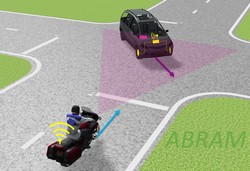The potential of autonomous emergency braking for motorcycles and mopeds
Autonomous emergency braking (AEB) is one of the most advanced safety systems available to modern passenger cars. Independent European safety bodies have recently demonstrated its effectiveness. However, AEB is not available for PTWs, and its potential suitability is undetermined. The EU-funded ABRAM (Autonomous braking for motorcycles) project addressed the major issues associated with evaluatiogn and implementing autonomous braking for PTWs. Work began with a literature review of the injury risk factors for motorcycle riders and the applicability of AEB to real-world crashes. Project partners developed and modified triggering algorithms for normal motorcycle crash scenarios. They assessed the potential benefits of AEB for motorcycles using computer simulations of real-world crash cases. The ABRAM team analysed the feasibility of a gentle, unforeseen automatic deceleration of a motorcycle from the viewpoint of the rider. It developed a low-cost motorcycle riding simulator to measure realistic steering inputs of riders in an emergency. The simulator was then used to study rider behaviour when facing AEB activation scenarios in a virtual environment. Researchers evaluated the validity of estimates of the effects AEB may produce in real-world motorcycle crashes. They also compared the potential benefits of both realistic and ideal AEB systems. An on-road test identified the current capabilities and limitations of a laser scanner sensor for obstacle detection that was applied to a motorcycle. Results were compared to the performances required by the triggering algorithms. Lastly, the team estimated the societal benefits of AEB for PTWs compared to other technologies. ABRAM successfully demonstrated the potential advantages offered by the AEB with respect to increased road safety for motorcyclists and its widespread application.
Keywords
Autonomous emergency braking, motorcycles, road safety, powered two wheelers, ABRAM

